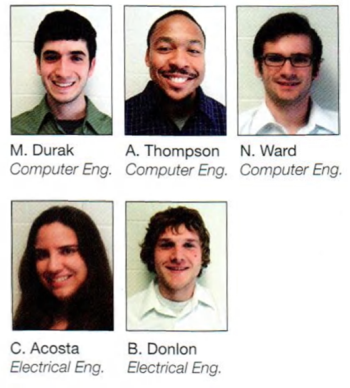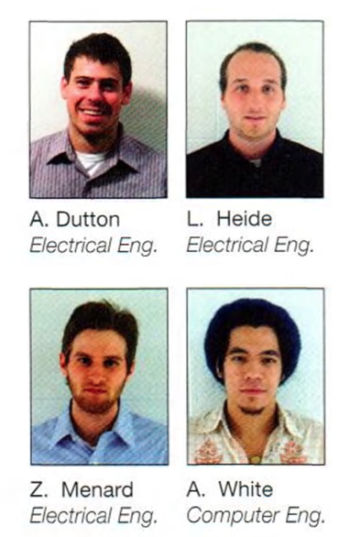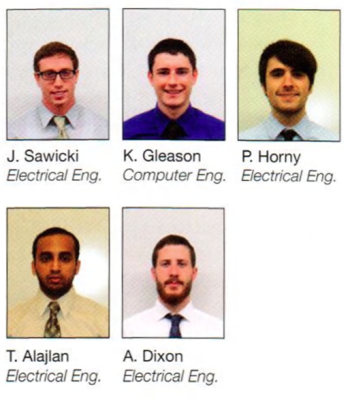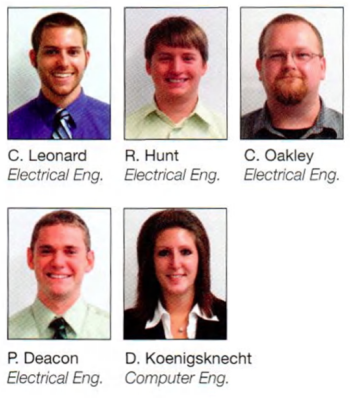Electrical Engineering
Projects
Electrical and Computer Engineering ECE 480 Senior Design is required of all electrical and computer engineering majors at MSU.
For information on becoming a project sponsor, please contact Gregg Motter.
The following are the project sponsors and projects for the fall of 2011:
Cypress Semiconductor: Arduino Friendly PSoC Shield
The Programmable System on Chip (PSoC), made by Cypress Semiconductor, is a configurable hardware component containing a CPU and programmable elements. It is used by numerous companies to build embedded systems. The purpose of this project is to provide a means to connect the PSoC to Arduino shields, in order for Cypress to expand its
market base. Until recently Arduino was a hardware platform for hobbyists
and students, but has recently been endorsed by Google as an Android Computer Eng. Development Platform. Arduino includes a CPU and can be connected to one or more daughterboards, known as shields,
 This project consists of interfacing the PSoC with the Arduino Ethernet Shield by physically connecting the pins. The PSoC general purpose 10 pins are configured and routed using the PSoC Creator application. The firmware for the PSoC to interface with the Ethernet Shield was written by modifying parts of the existing Arduino libraries to integrate with the Cypress software libraries.
This project consists of interfacing the PSoC with the Arduino Ethernet Shield by physically connecting the pins. The PSoC general purpose 10 pins are configured and routed using the PSoC Creator application. The firmware for the PSoC to interface with the Ethernet Shield was written by modifying parts of the existing Arduino libraries to integrate with the Cypress software libraries.
Several internet applications were developed to demonstrate the capabilities o f the project. These demos include writing to an SD card on the Ethernet Shield as well as interfacing with other hardware to prove Ethernet capabilities. The team has also developed a custom printed circuit board as the final prototype which could be used with other Arduino shields.
RCPD: iDOCENT Phase II: Indoor Digital Orientation Communication and Enabling Navigation Technology
The iDOCENT Phase II is a continuation of an indoor navigational smartphone application system for the Michigan State University Resource Center for Persons with Disabilities. The main purpose of iDocent is to guide the visually impaired, visitors, and emergency personnel inside campus buildings. iDOCENT Phase I made use of existing Wi-Fi
access points to triangulate location of an individual. Phase II system utilizes microphone modules to receive a sound signal from a smartphone speaker. Microphone units are connected to the server via existing Ethernet network. Ethernet provides fast communication between modules and the server and supplies power to each microphone unit.
 The system command prompts are voice or touch activated, depending on user preferences and abilities. Once the user opens the application, the correct map structure is automatically downloaded. The application will then establish communication with the server. The server registers each user based on their phone number. After confirmation, a high frequency audio signal will be sent through the smartphone speaker. Microphone modules will receive the signal and pass it to the server. This signal will be received by the three closest microphones in the area. The microphones will individually encode a time stamp when the signal is received and forward to the server. Based on collected data, the server will triangulate the current location of the user. The application will also enable users to select points of interest, such as emergency exits, and efficiently navigate the user to that location.
The system command prompts are voice or touch activated, depending on user preferences and abilities. Once the user opens the application, the correct map structure is automatically downloaded. The application will then establish communication with the server. The server registers each user based on their phone number. After confirmation, a high frequency audio signal will be sent through the smartphone speaker. Microphone modules will receive the signal and pass it to the server. This signal will be received by the three closest microphones in the area. The microphones will individually encode a time stamp when the signal is received and forward to the server. Based on collected data, the server will triangulate the current location of the user. The application will also enable users to select points of interest, such as emergency exits, and efficiently navigate the user to that location.
RCPD: iDOCENT: iNODES for Wi-Fi Network Enhancement
In the past, navigation typically consisted of an individual looking at a map on printed paper. As technology advances, individuals in today’s society are shifting to an electronic lifestyle. Today, people rely on GPS as a means of navigation in outdoor environments, but are still reliant on diagrams or maps while indoors. This is because GPS signals typically will
not penetrate the physical structures that humans encounter on a daily basis.
 Indoor Digital Orientation Communication and Enabling Navigational Technology (iDOCENT) is a cell phone application aimed to assist navigation throughout buildings on Michigan State University’s campus. The software application can direct an individual along the best path to a specified location while vocally speaking turn by turn directions. iDOCENT uses existing Wi-Fi access points supplemented with the iNODE to receive the device’s signal strength for localization purposes. The iNODE is designed to increase system accuracy of a building outfitted with an existing Wi-Fi network, as well as making a building without Wi-Fi capable for iDOCENT navigation. The ultimate iDOCENT system will enhance the ability for any individual to navigate through an iDOCENT mapped building efficiently. This application is designed primarily for visually impaired individuals, but could also be useful for anyone unfamiliar with the Michigan State campus.
Indoor Digital Orientation Communication and Enabling Navigational Technology (iDOCENT) is a cell phone application aimed to assist navigation throughout buildings on Michigan State University’s campus. The software application can direct an individual along the best path to a specified location while vocally speaking turn by turn directions. iDOCENT uses existing Wi-Fi access points supplemented with the iNODE to receive the device’s signal strength for localization purposes. The iNODE is designed to increase system accuracy of a building outfitted with an existing Wi-Fi network, as well as making a building without Wi-Fi capable for iDOCENT navigation. The ultimate iDOCENT system will enhance the ability for any individual to navigate through an iDOCENT mapped building efficiently. This application is designed primarily for visually impaired individuals, but could also be useful for anyone unfamiliar with the Michigan State campus.
Battelle Laboratories: Smartphone Control Advanced Sensor Systems
 Team four is sponsored by Battelle, a non-profit research and development organization that addresses the needs of government and industry. The goal of our project is to control an advanced sensor system through the use of a common android smartphone. This sensor system was designed to analyze the amount o f harmful chemicals in the air and trigger an alarm if they exceed a safe level. Due to the dangers associated with occupying the area around the sensor, it is desired to communicate to it wirelessly from a remote location. The aim of our team is to provide Battelle with a graphical user interface (GUI) that enables the user to control and monitor the sensors from an Android smartphone. In addition the team has documented a study of viable communication options such as radio frequency, WI-FI and Zigbee. The team then assembled a circuit that enabled wireless communication. The performance and operability of this design was demonstrated using a laptop to simulate one of the sensors.
Team four is sponsored by Battelle, a non-profit research and development organization that addresses the needs of government and industry. The goal of our project is to control an advanced sensor system through the use of a common android smartphone. This sensor system was designed to analyze the amount o f harmful chemicals in the air and trigger an alarm if they exceed a safe level. Due to the dangers associated with occupying the area around the sensor, it is desired to communicate to it wirelessly from a remote location. The aim of our team is to provide Battelle with a graphical user interface (GUI) that enables the user to control and monitor the sensors from an Android smartphone. In addition the team has documented a study of viable communication options such as radio frequency, WI-FI and Zigbee. The team then assembled a circuit that enabled wireless communication. The performance and operability of this design was demonstrated using a laptop to simulate one of the sensors.
Texas Instruments: Wireless Sensing System for Intelligent Concrete Curing
There is currently no reliable data driven method of tracking the completion of the concrete curing process. Applying pressure to concrete prematurely has the potential to cause severe damage. Ideally, the curing process could be monitored by embedding multiple sensors within the concrete interior. Through wireless transmission we can receive, interpret, and provide this data to the user.
 Utilizing the MAVRK and uMAVRK platforms provided by Texas Instruments, along with multiple software elements, and signal conditioning circuitry, our team was able to prototype an effective design that extracts temperature and humidity readings from the curing concrete and display this data on to a centralized unit that is easily accessible by an end user. The decision to officially claim the concrete as cured will be left up to the end user.
Utilizing the MAVRK and uMAVRK platforms provided by Texas Instruments, along with multiple software elements, and signal conditioning circuitry, our team was able to prototype an effective design that extracts temperature and humidity readings from the curing concrete and display this data on to a centralized unit that is easily accessible by an end user. The decision to officially claim the concrete as cured will be left up to the end user.
The final system is comprised of a sensor module. uMAVRK and the MAVRK. The sensor module interfaces directly with the uMAVRK. This PCB module houses sensors for humidity and temperature data acquisition as well as signal conditioning circuitry. The uMAVRK converts the analog sensor information into a digital signal and transmits this information to the MAVRK via a RF UART. The MAVRK is programmed to accept data from the uMAVRK and display this data on a host computer.
MIT Lincoln Laboratory: Remotely Operated Intrusion Alarm
Our design team is working with MIT Lincoln Laboratory to create a Remotely Operated Intrusion Alarm. This project has been developed in a smaller version, which was previously designed by MIT Lincoln Laboratory as a classroom project. However, that system has many shortcomings such as slow processing speed, low accuracy and poor portability.
![]() The goal of this project is to prototype a stand-alone radar system that overcomes these faults. The final system detects an intruder and sends a message with information pertaining to the intrusion to the user via text or email.
The goal of this project is to prototype a stand-alone radar system that overcomes these faults. The final system detects an intruder and sends a message with information pertaining to the intrusion to the user via text or email.
In the beginning of the operational flow the 2.4GHz radar scans the room and sends an audio signal through a filter and into the TI PCM 1808 ADC. The ADC then converts the data and ports it to the TI Stellaris LM3S9D92. The Stellaris performs the necessary calculations to detect an intruder and measure its speed and distance. This data is sent to a PC via Ethernet connection, which subsequently attaches a timestamp. The PC can then send alert messages to via text message or email to relay the information of the intrusion.
This design is small, power efficient, and will allow maximum sampling rate in order to obtain real-time data, as well as system portability.
MIT Lincoln Laboratory: Portable Range Doppler Radar System Detecting Objects with Coffee Cans
Our group’s task was to expand the functionality of an existing design MIT developed for a home-built short-range radar system. Our sponsor. MIT Lincoln Laboratory, provides a
radar oriented course at MIT using this system. Our main goal was to expand functionality and accuracy of the system and in so doing provide a real-time GUI interface displaying what the radar system is illuminating. Both range and Doppler information are used to inform the user of targets that are in the illumination band, for example, if a car passes in front vs. a bike or pedestrian.
![]() Since this system is intended to be mobile and used in the field, power limitations are very important. Thus, low-power components were chosen to interface between the system and the laptop. The previous implementation of the radar system used the laptop’s line in port, where the associated software translated the audio signal to range and Doppler information. Our implementation uses a much higher sample rate in order to achieve more accurate data.
Since this system is intended to be mobile and used in the field, power limitations are very important. Thus, low-power components were chosen to interface between the system and the laptop. The previous implementation of the radar system used the laptop’s line in port, where the associated software translated the audio signal to range and Doppler information. Our implementation uses a much higher sample rate in order to achieve more accurate data.






